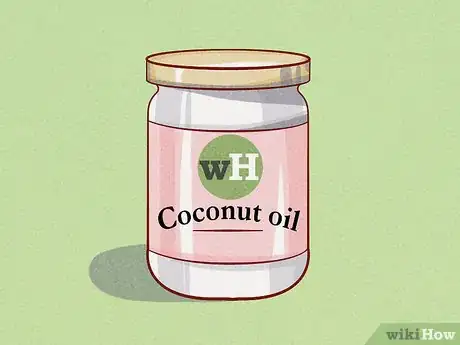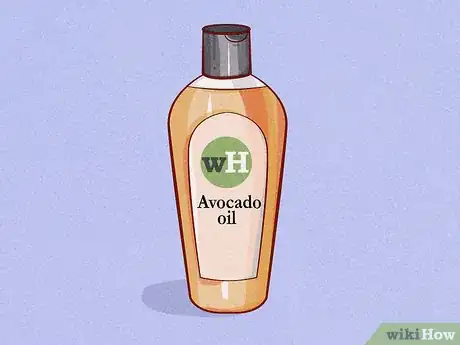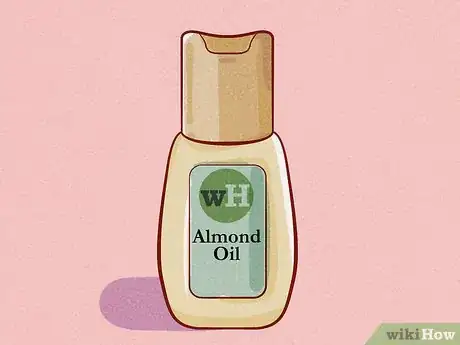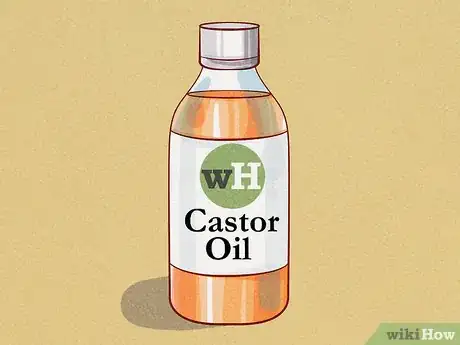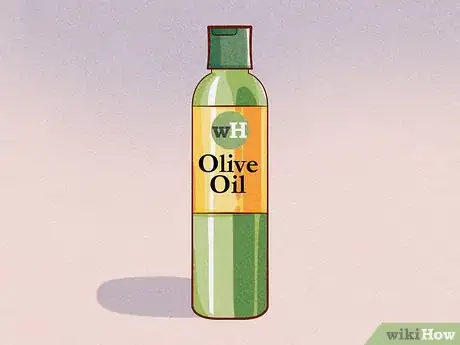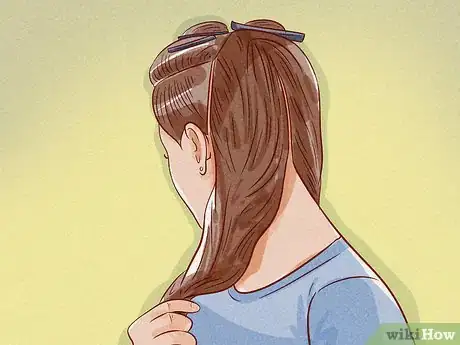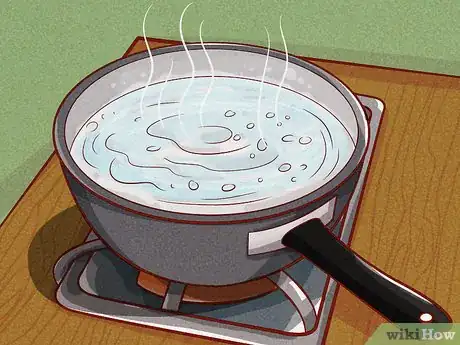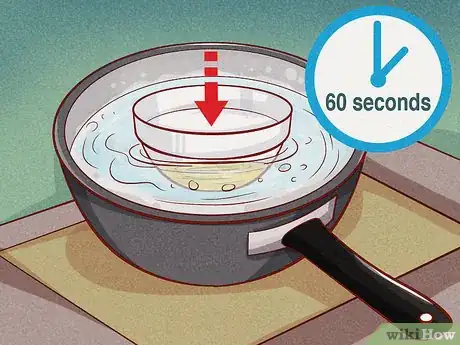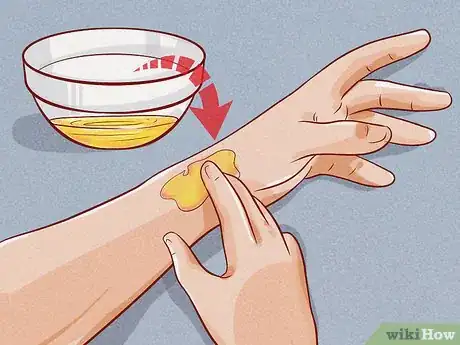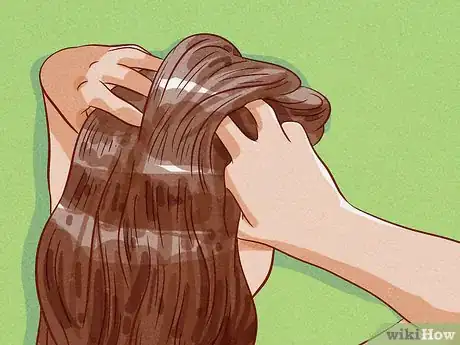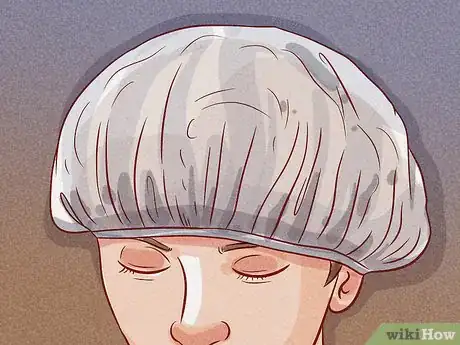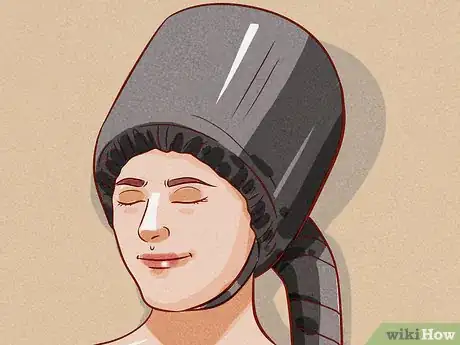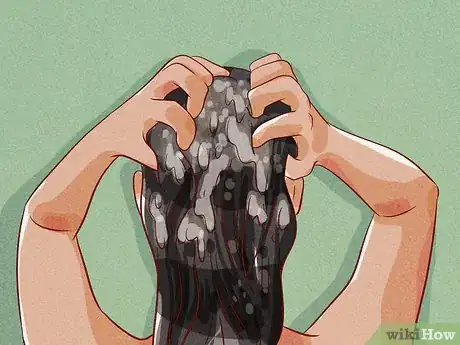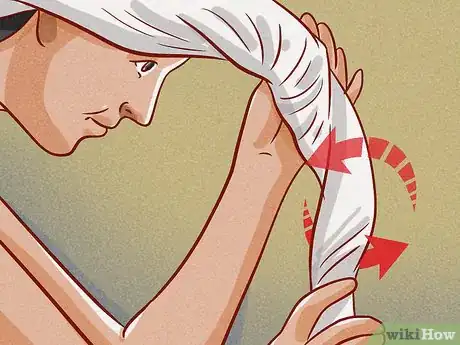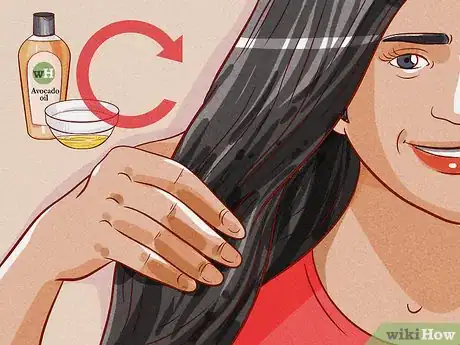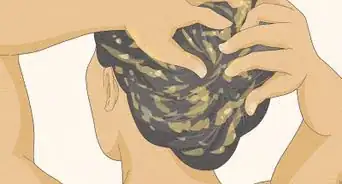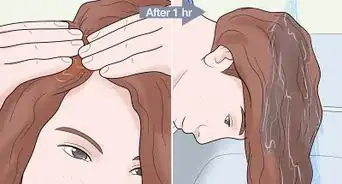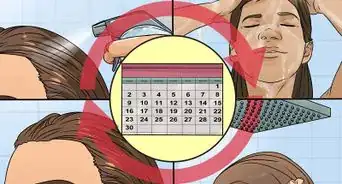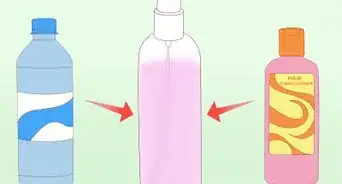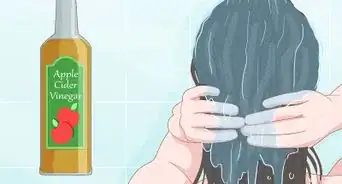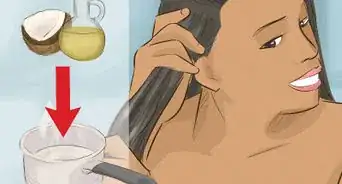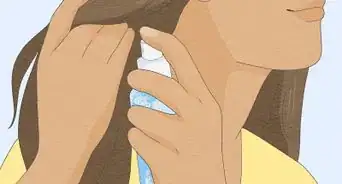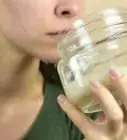This article was co-authored by Kelsey Morey and by wikiHow staff writer, Danielle Blinka, MA, MPA. Kelsey Morey is a Professional Hair and Makeup Artist, Model and the Owner and Founder of Haus of Pretty based in Westport, Connecticut. With more than ten years of experience, she specializes in balayage, hair care, color care, and photoshoot styling. Kelsey received her training from Brio Academy of Cosmetology and John Casablancas Modeling and Career Center. She also completed her apprenticeship with Warren Tricomi luxury salons.
There are 10 references cited in this article, which can be found at the bottom of the page.
This article has been viewed 30,476 times.
A hot oil treatment can moisturize and strengthen your hair, while possibly stimulating hair growth. To get maximum benefits from your treatment, choose the right oil for your needs. Then, heat and apply your oil to your hair and cover it with a shower cap. After the treatment, wash and condition your hair as you normally would. Don’t wash your hair before you do your oil treatment because you’ll use shampoo to remove the oil.
Things You Should Know
- Make your own at-home hair treatment with a nourishing oil like coconut, avocado, jojoba, sweet almond, castor, or olive oil.
- To gently heat the oil to just the right temperature, pour it into a heat-proof bottle or bowl, then submerge that in very hot water for 60 seconds.
- Start by applying a small amount of the warm oil onto your scalp, then massage it down through the rest your hair, adding more oil as needed.
- To help the oil penetrate your hair, cover your hair with a shower cap and sit under a hooded dryer for 30 minutes.
Steps
Choosing Your Oil
-
1Use coconut oil for an easy, lightweight oil treatment for all hair types. Coconut oil is a popular choice for hot oil treatments because it’s lightweight and absorbs easily. This means it will help moisturize and protect your hair without leaving a greasy film. Choose coconut oil if you want extra moisture or aren’t sure which oil is right for you.[1]
- It’s normal for coconut oil to be solid at room temperature. However, it will melt when it’s heated, making it easy to apply to your hair.
-
2Try avocado oil if your hair is dry. Avocado oil will add extra moisture to your hair and may improve the texture of your hair, as well. It’s a great option if your hair is really dry because it adds more moisture than lightweight oils but isn’t so thick that it sits on your hair shaft. Pick avocado oil as a treatment for dry or very dry hair.[2]
- Avocado oil retains its nutrients even when it’s heated to high temperatures, so it’s easy to use for hot oil treatments.
Advertisement -
3Opt for jojoba oil if you have dandruff. Jojoba oil is also very lightweight, so it will penetrate your hair easily. It should leave your strands feeling moist and soft. Additionally, it may help with scalp conditions, like dandruff. If you want to relieve scalp irritation, try jojoba oil.[3]
- Keep in mind that oil treatments may make some scalp conditions worse. It’s best to talk to a dermatologist to find out what’s causing your itchy scalp or dandruff.[4]
-
4Apply sweet almond oil is you want to stimulate hair growth. In addition to adding moisture to your hair, almond oil may help your hair grow faster. While it doesn’t work the same way for everyone, you might want to try it if you’re hoping for longer hair. Look for 100% sweet almond oil to use for your oil treatment.
- How fast and how long your hair can grow depends heavily on genetics, but for most people hair grows at a rate of 0.5 in (1.3 cm) per month.[5] Although almond oil may be able to help in some cases, it can’t change your genetic makeup.
-
5Try castor oil if you want to strengthen your hair. For moisture and strength, castor oil may be your best bet. While it’s thick, it also absorbs quickly into your hair. Pick Jamaican Black castor oil for best results.
- Regular castor oil can work, but Jamaican Black castor oil is the best option for hair treatments on thinning hair and areas with breakage.
-
6Choose olive oil if you want to protect your ends from splitting. Olive oil is packed with vitamins, so it’s great for at-home beauty treatments.[6] However, it’s also a heavier oil, so it may not absorb as well as other lightweight oils, like coconut oil.[7] Because it coats your shaft, it will help protect your ends. Use it if you’d like to prevent split ends.
- Don’t use a lot of olive oil on your hair, as it will weigh your hair down and might cause it to look greasy. Apply just enough to create a thin layer on your hair.
- When using olive oil, apply more oil to the ends of your hair than to your roots so your hair won’t look greasy.
Heating Your Oil
-
1Divide your hair into 4-6 sections to make application easier. First, divide your hair down the middle to create 2 large sections. Next, divide your hair from ear-to-ear to create a total of 4 sections. Use hair clips to secure each section in place until you’re ready to apply the oil.
- If your hair is thick, divide your hair along your temples and from ear-to-ear to create 6 total sections.
-
2Pour about 3 tsp (15 mL) of oil into a heatproof bowl or applicator bottle. It’s okay to estimate how much oil you’re using, so don’t worry about getting your measurement exact. Use a measuring spoon or pour the oil directly into your bowl or bottle.[8]
- If you have long or thick hair, you may need more oil for your hair treatment.
- You can use the same type of applicator bottle as you'd use for hair dye. It will have a long nozzle on the top, which attaches to a flexible plastic container. You can find 1 at a beauty store or online. The applicator bottle is easiest to use, but you can use a bowl if that’s all you have.
-
3Bring a pot of 2 to 3 in (5.1 to 7.6 cm) of water to boiling on your stove. Heat the water over high heat until you notice bubbles rising from the bottom. Then, remove the water from the heat.
- Be careful not to burn yourself while you’re handling the hot pot. You may want to wear an oven mitt.
-
4Put the bottle or bowl into the hot water for 60 seconds to heat it. Use a towel or oven mitts to protect your skin from the steam. Then, submerge the bottom of your bowl or bottle into the pot of hot water. Keep the top of your container above the water line. Hold the container in the water for about 60 seconds to warm it. Then, remove it from the water and set it on a towel.
- If you’re using a lot of oil for your treatment, it may take longer to get warm.
- Don't expose your bare skin to the steam, and make sure your oven mitt or towel stays out of the water. Hot water can cause burns.
- Don’t leave your pot on the hot burner while you do this. You don’t want your bowl or bottle getting heated by the burner itself.
Variation: Heat your oil in the microwave on high for 30 seconds or until it feels warm.[9] However, keep in mind that your oil may lose nutrients during heating.
-
5Test the oil on your wrist to make sure it feels warm. Lightly hold the tip of your index finger over the oil to see if it's radiating heat. If it feels warm or cool, dip your finger into the oil, then rub the oil onto your wrist. Check that it feels warm.
- If the oil is still cool, put it back into the hot water for 30-60 seconds, then test it again.
- If your finger feels heat coming off the surface of the oil, wait about 1 minute to let it cool. Then, try again.
Applying the Oil to Your Hair
-
1Use your fingers or the tip of your applicator bottle to apply the oil. Dip your fingers in the oil, then stroke it onto your hair. If you’re using an applicator bottle, put the applicator tip against your hair and squeeze a small amount of oil onto your scalp. Then, work the hair down your strands.
- It’s best to apply a small amount at first, even if you think it’s not enough. You can apply more oil as needed.
-
2Massage the oil from your scalp to your ends to distribute it evenly. Use your fingertips to gently massage your scalp. Then, move down the shaft of your hair, working the oil into your hair. Create an even layer from your roots to your ends so that you don’t leave any areas untreated.[10]
- If you’re applying olive oil to treat your ends, apply minimal oil at your roots and a lot of oil at your ends.
-
3Cover your head with a plastic shower cap to seal in your body heat. The shower cap will keep the oil from dripping down your face and neck. Additionally, it will keep the oil warm and slow it’s drying time by capturing the heat from your head.[11]
- You can use a regular shower cap or a disposable single-use shower cap. These are available at your local beauty supply store or online.
-
4Sit under a hooded dryer or wear a heat cap to help the oil absorb. Heat helps open your hair shaft so the oil can penetrate your hair. The hot oil will already open your hair shaft some, but applying additional heat will help your treatment work better. Use a hooded dryer on a low setting or a heat cap if you have one.[12]
- As another option, steam your hair by draping a hot, moist face cloth over your shower cap. Seal in the steam by placing a second shower cap over the face cloth to trap in the moisture.
Variation: Use a warm towel to add heat to your treatment. Dampen the towel with warm water or heat a damp towel in your microwave for about 30 seconds. Then, wrap the towel around your head for 30 minutes.
-
5Let the oil sit on your hair for at least 30 minutes. This allows the oil time to penetrate and moisturize your hair. If you want a deeper treatment, it’s okay to leave the oil on your hair longer. However, stop applying heat after 30 minutes so your hair doesn’t get heat damage.
- Start by trying a 30-minute treatment. Then, you can add time to your treatments if you prefer.
Variation: Let the oil sit on your scalp overnight for an intense treatment. After applying the oil, cover your head with a plastic shower cap, then wrap a heat cap or towel around your head to seal in the heat and protect your sheets. Place a towel over your pillowcase to protect it as well. Then, wash out the oil treatment in the morning.[13]
Removing the Oil Treatment
-
1Rinse and shampoo your hair to remove the oil. Use warm water to rinse your hair, then apply a quarter-sized amount of shampoo. Massage the shampoo into your hair to remove the oil. Then, rinse with warm water.[14]
- You may need to apply more shampoo if your hair is long or thick or if you used a lot of oil.
- It may help to apply shampoo to your hair first and then rinse it out. After that, follow up with another pump of shampoo to fully wash out the oil.
-
2Apply conditioner to your hair and let it sit for 3 minutes before rinsing. Coat your hair with a thin layer of conditioner. Start at your ends and work your way up to your roots. Wait at least 3 minutes, then rinse your hair with cool water.
- The cool water will seal your cuticle, which makes your hair look shinier. This also seals in the moisture from the oil treatment.
- You can use your regular conditioner or a deep conditioner.
-
3Use an absorbent towel to gently squeeze water from your hair to dry it. Start by pressing your ends to remove a lot of water at once. Then, lightly squeeze your hair starting at your roots and working your way down. Try to remove as much water as possible to reduce stretching and breakage.[15]
- A microfiber towel works best because it won’t damage your hair.
- Don’t rub your hair, as this can damage it and cause frizz.
-
4Repeat your oil treatment 1-2 times per week for healthy hair. Use the same oil every time or try different oils to see how they affect your hair. Do the treatment weekly at first. Then, add in a second weekly treatment if you aren’t seeing the results you want.[16]
- If your hair starts to look oily, cut back on your hot oil treatments.
Warnings
- If you have an itchy, flaky scalp, oil treatments may make it worse. Flaky scalp is often caused by yeast, which feeds on oil.[17]⧼thumbs_response⧽
Things You'll Need
- Oil of your choice
- Heatproof bowl or applicator bottle
- Large pot
- Water
- Towel or oven mitt
- Shower cap
- Hooded dryer (optional)
- Heat cap (optional)
- Face cloth (optional)
- Extra shower cap (optional)
- Hot towel (optional)
- Shampoo
- Conditioner
- Absorbent bath towel
References
- ↑ https://www.refinery29.com/en-us/hot-oil-treatment-for-hair-benefits
- ↑ https://www.naturallycurly.com/curlreading/home/top-5-oils-for-the-best-hot-oil-treatment-hi
- ↑ https://www.naturallycurly.com/curlreading/home/top-5-oils-for-the-best-hot-oil-treatment-hi
- ↑ https://www.refinery29.com/en-us/hot-oil-treatment-for-hair-benefits
- ↑ https://www.ncbi.nlm.nih.gov/pubmed/5173315
- ↑ https://www.naturallycurly.com/curlreading/home/top-5-oils-for-the-best-hot-oil-treatment-hi
- ↑ https://www.refinery29.com/en-us/hot-oil-treatment-for-hair-benefits
- ↑ https://www.youtube.com/watch?v=ca97e8DUgxw&feature=youtu.be&t=43
- ↑ https://www.youtube.com/watch?v=ca97e8DUgxw&feature=youtu.be&t=47
- ↑ https://www.youtube.com/watch?v=ca97e8DUgxw&feature=youtu.be&t=77
- ↑ https://www.youtube.com/watch?v=ca97e8DUgxw&feature=youtu.be&t=85
- ↑ https://www.youtube.com/watch?v=ca97e8DUgxw&feature=youtu.be&t=85
- ↑ https://www.naturallycurly.com/curlreading/home/top-5-oils-for-the-best-hot-oil-treatment-hi
- ↑ https://www.youtube.com/watch?v=ca97e8DUgxw&feature=youtu.be&t=108
- ↑ https://www.byrdie.com/how-to-dry-hair-properly
- ↑ https://www.goodhousekeeping.com/beauty/hair/how-to/a47863/how-to-use-coconut-oil-for-hair/
- ↑ https://www.refinery29.com/en-us/hot-oil-treatment-for-hair-benefits
